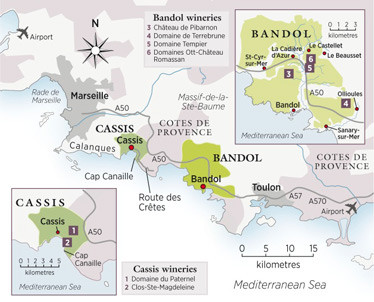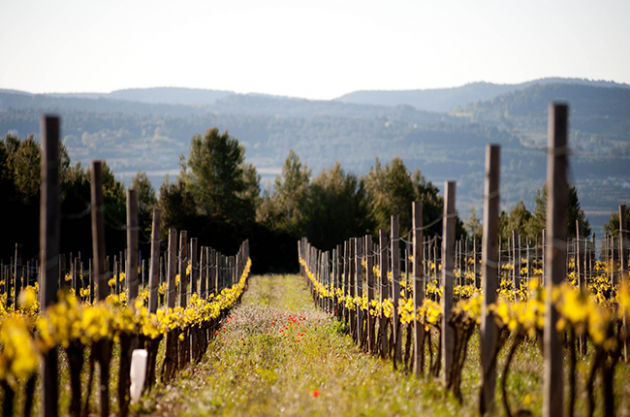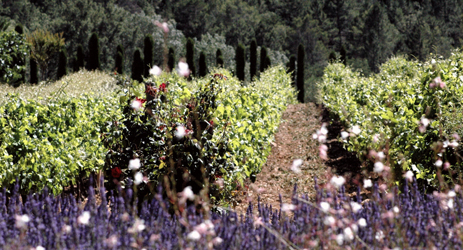Captivating Cassis and its bountiful neighbour
Evenings slide by easily, you will find, in a smart little town that has managed to hang on to its Provençal soul.

Captivating Cassis
With just 12 estates (more than half of them organic), pocket-sized Cassis is easy to get around, even if time is short. Graceful white wines with floral, citrus and honey tones and a mineral, almost salty undertow account for roughly 70% of its output and fine-boned rosés 25%, with reds from a handful of producers making up the balance.
‘Cassis is the only southern French appellation to specialise in white wines,’ stresses Olivier Santini of Domaine du Paternel (www.domainedupaternel.com), president of the producers’ syndicate. ‘And the only appellation situated entirely within a national park.’ Created in 2012, the protected Massif des Calanques encourages environmental awareness among producers while helping to safeguard their vineyards from developers.
To get a feel for Cassis, drive up the craggy limestone spine of the Route des Crêtes and look down on the appellation. Then, as most estates welcome visitors, pick up details at the tourist office on the harbour and away you go. Particularly recommended is ravishing Clos-Ste-Magdeleine (www.clossaintemagdeleine.fr, guided tour €14), with vineyards plunging down to the sea, a sumptuous Art Deco villa and wines of exceptional finesse.
After a few domaine visits, all that remains is to see how well Cassis wines suit a dinner of freshly landed fish or the famous (ultra-filling) local fish soup bouillabaisse. Evenings slide by easily, you will find, in a smart little town that has managed to hang on to its Provençal soul. Chic et authentique: for once the marketing slogan is spot-on.
A bountiful neighbour
Bandol may need a bit more time because more than 50 estates are dotted around eight communes between the Massif de la Ste-Baume and the coast. Rosé easily dominates production in volume terms and deserves more than a casual glass: many examples are impressive food wines, especially with a year or two of age. Suave whites sprinkled across the appellation may also catch your attention.
But of course Bandol’s glory hangs on majestic reds based on Mourvèdre. Nowhere else does this late-ripening grape play a leading role with quite so much élan, giving silky, sinewy, rich wines stamped with the freshness of cool sites near the sea.
One recent change which those on a tasting tour will welcome is that, whereas Bandol reds used to need years to tame their stern tannins, they are now enjoyable soon after the 18 months in cask that the appellation demands. ‘Climate change has helped,’ says Eric de St-Victor, proprietor of Château de Pibarnon (www.pibarnon.fr), whose wines walk the tightrope between power and elegance with ease. ‘But so has paying attention to detail – picking at the right moment and deciding how much to destem.’
Also noticeable over the past decade has been a move to renew very old casks. Large foudres are the preferred format: ‘They protect the fruit and the terroir,’ says Reynald Delille of organic Domaine de Terrebrune (www.terrebrune.fr), near the coast and noted for its subtle, supple wines. But thankfully for visitors who end up buying several cases to tuck away, Bandol’s remarkable staying power remains constant, relating more closely to Mourvèdre’s star performance on local limestone with Jurassic and Triassic soils than to any winemaking decisions.
‘We have the same amount of tannins as before, but now they’re rounder and less aggressive,’ explains Daniel Ravier, winemaker at renowned Domaine Tempier (www.domainetempier.com), an estate dating back to the time of Louis XV and prominent ever since owner Lucien Peyraud drove the appellation forward in the 1940s. ‘The wines still keep magnificently. Our UK clients understand this particularly well. One told me recently: “We absolutely love old Bandol”.'
I can appreciate their point of view, having admired the 1986 – not a great vintage apparently – at both Pibarnon and Château Romassan (part of the Domaines Ott group, owned by Champagne Louis Roederer since 2004, www.domaines-ott.com). So silky, so harmonious, so vibrant... ‘Ah yes,’ grins Jean-François Ott. ‘Down here, Mourvèdre can be extremely refined.’
If you happen upon an older vintage, remember that, besides going beautifully with lamb or beef with mushrooms or truffles, it may well shine in a dish that includes tapenade, given the black olive tones of many mature Bandol reds. As for slightly older rosés, try them with saffron-rich dishes or white meats, again with mushrooms or truffles. They can also be splendid with Thai food – in limited supply around the Med, admittedly, so ensure you bring a bottle or two home.
How to get there:
By plane: Fly to Marseille or Toulon. Cassis is 40 minutes’ drive from Marseille airport and an hour from Toulon; Bandol is 40 minutes’ drive from Toulon airport and an hour from Marseille.
Translated by Sylvia Wu / 吴嘉溦
All rights reserved by Future plc. No part of this publication may be reproduced, distributed or transmitted in any form or by any means without the prior written permission of Decanter.
Only Official Media Partners (see About us) of DecanterChina.com may republish part of the content from the site without prior permission under strict Terms & Conditions. Contact china@decanter.com to learn about how to become an Official Media Partner of DecanterChina.com.




Comments
Submit